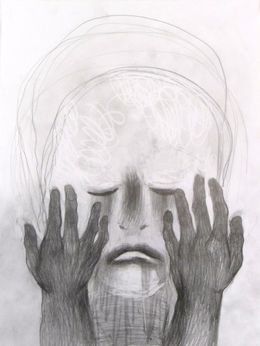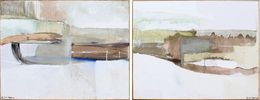
Meet Kathleen Bühler: The art historian, critic and exhibition curator welcomes Artsper to Switzerland!

Kathleen Bühler, Photo: Sarah Maurer
This week, Artsper had the pleasure of sitting down with Kathleen Bühler, the contemporary art historian, critic and curator! Now based in Zurich, Kathleen is the lead curator at the Museum of Fine Arts in Bern. Evidencing her commitment to the development of artistic culture across Switzerland, Kathleen's curatorial projects interrogate key cultural themes, such as female beauty, artistic diversity, and social inequality. Our team spoke to Kathleen about her career journey thus far, her observations of trends in the contemporary art world, and her most recent, industry-defining projects! Welcome to the world of Kathleen Bühler!
1. Hi Kathleen! Your work as an art historian has led you to become lead curator of the Contemporary Art Department at the Kunstmuseum Bern. Can you tell us more about your professional career and how you came to this position?
While I was still studying art history, film studies and philosophy, I worked as an intern in art museums and gained practical experience. I assisted, organized graphic collections, recorded data, curated my first small exhibitions, and learned museum work from the ground up. In the process, I discovered the great potential of curatorial work, when it not only depicts art histories, but also questions historical, cultural, and ideological settings. Curating turned out to be the most exciting work in the world for me. In doing so, I was able to engage with art as well as take up current issues and examine them in the context of exhibitions.


Left: Miriam Cahn, geologie, 16.10.96 (traum 8.10.96), 1996 (Detail image, Museum of Fine Arts Bern, Donation Kunst Heute Foundation) / Right: Maria Lassnig, Rosa Elektrizität: oder: Elektrisches Selbstportrait II, 1993 (Detail image, Museum of Fine Arts, Foundation Kunsthalle Bern)
2. What current trends and developments do you see in the contemporary art scene and how are they reflected in the exhibitions and collections of the Kunstmuseum Bern? And how do you ensure that the Kunstmuseum's exhibitions and programs remain current and take the pulse of the times?
I see all the forms of the digital as current trends, then the preoccupation with a posthumanist worldview, with ecology in the broadest sense, and diversity. Since the 90s at the Kunstmuseum Bern, we've been trying to break up the established canon with our exhibitions and to bring more diversity into our collection and exhibition program. We were the first in Switzerland to consistently focus on female artists or pairs of artists (Jackson Pollock and Lee Krasner, Josef and Anni Albers, Marina Abramović, Tracey Emin, Miriam Cahn, Katharina Grosse). We have been collecting and showing artworks by non-European artists since the noughties (Chinese contemporary art, South and North Korean art, Teruko Yokoi, Kader Attia, Kim Sooja, Nam June Paik, El Anatsui, Tracey Rose, Zarina Bhimji).
3. Katharina Grosse, Meret Oppenheim, Miriam Cahn... to name just a few of the remarkable women artists who have found a special place in the Kunstmuseum Bern. How do you deal with diversity and inclusion, especially in terms of feminist approaches, and how do you promote a representative diversity of women artists in your exhibitions and collections? How do you decide which artists or artworks to focus on in the exhibitions, and what criteria play a role?
I was already a feminist during my school years, so it seemed logical to me to pay attention to a more gender-just distribution when collecting and exhibiting. Here at the Kunstmuseum Bern, for the past fifteen years, we have been collecting art by women artists in preference (Meret Oppenheim, Louise Bourgeois, Maria Lassnig, Suzan Frecon, Berlinde De Bruyckere, Etel Adnan, to name just a few). In thematic exhibitions, I look for gender balance, and in our collection exhibitions, we focus on the margins of art history. The criteria are the same as for classical exhibitions: we show artists and works that seem to us to be exciting, topical or unusual, and which deserve a closer look - not least because they have previously been overlooked.


Left: Meret Oppenheim, Die vier Elemente. Wasser, 1963 (Detail image, Museum of Fine Arts Bern, Anne-Marie and Victor Loeb Foundation) / Right: Katharina Grosse, Ohne Titel, 2005 (Detail image, Museum of Fine Arts Bern, Donation Mrs. Marlies Kornfeld for the Contemporary Department)
4. You curate by profession. We'd love to know what art you "curate" in your home? Which artists do you currently have a particular focus on and why?
I don't collect at home as systematically as I do at the art museum. My artworks are mementos, biographical signs of the times, and form a very personal smorgasbord. They are works of art by people who play a role in my life. At home, I want to relax and nourish myself, so I appreciate poetic, sensual works that are also full of abysmal humor.
5. The Kunstmuseum Bern is known for its dedicated provenance research and restitution practice, especially in connection with the processing of Nazi looted art. How does the Kunstmuseum deal with this historical responsibility and how do you, as a curator, design the presentation of works to encourage museum visitors to reflect on these issues?
Provenance research has extended to the entire art collection of the Kunstmuseum Bern. In this way, we show that we understand responsibility in a broader sense. When exhibiting works from the collection, we reflect the current state of our research and strive to consistently close the gaps in our knowledge. In addition, we provide transparent information on all these topics so that we can be held accountable at any time.
Their favorite artworks


















